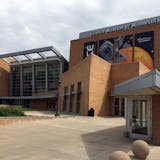While conveyor belts circulated suitcases of every size, color and shape around her, artist Jen Lewin dipped a black-booted foot onto a glass "lake" atop the floor at Minneapolis-St. Paul International Airport's baggage claim.
As she pressed her foot, the purple-colored perimeter zipped into red, then yellow tones.
"There's just sort of infinite colors," Lewin said dreamily.
Then she started tapping both feet on the translucent surface while waving her hands in the air and swaying in place.
Above her, "The Aurora," a 29-foot-tall glass-and-metal spiral studded with handblown bulbs containing thousands of LED lights, reflected her movements using heat-map-tracking cameras. It was March 1, a springlike day, so software in Lewin's sculpture triggered a springtime palette of purples, blues, greens, reds and yellows.
Airport visitors noticed Lewin gliding on the cluster of eight interactive lakes she created as they marched to bathrooms, baggage in hand. A couple of construction workers in neon yellow vests took a break to dance on the lakes. Some people paused and looked up, observing the colorful simulation of the aurora borealis dangling from the Terminal 1 ceiling, far overhead.
"Adults usually are cautious," Lewin observed. "Kids get it immediately."
After nearly a year of COVID delays and three years of planning, "Aurora" has arrived.



